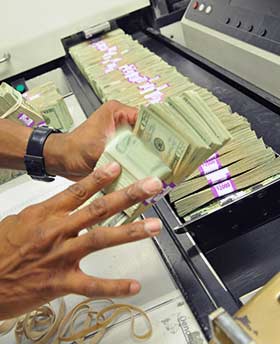Four Simple Ways to Spot Counterfeit Currency
The Federal Reserve, U.S. Treasury and Secret Service work in conjunction to make sure our country’s currency is hard to counterfeit. Each paper note from $1 to $100 is enhanced with detailed security features designed to make it hard for criminals to reproduce.
Here are four ways to detect counterfeit money. (Spoiler alert: it can be tougher than you think.)
1. Trust your touch.
Feeling a bill can be one of the easiest ways to tell whether money is real or fake. An authentic note will actually feel slightly rough to the touch, as U.S. currency uses a unique printing process that results in slightly raised ink. Is the bill you’re holding smooth? It might be a counterfeit.
2. See the light.
On denominations $5 and higher, a security “thread”—or small ribbon—is embedded vertically inside the bill. You can see this thread when holding the bill up to a light. When held under UV light, these threads each glow a different color. No thread? Check the year it was printed; notes printed prior to 1990 did not contain a security thread.
3. Get moving.
Tilting the bill top-to-bottom or side-to-side can reveal another unique feature of our currency: color-shifting ink. Several small images on currency denominations of $10 and higher contain ink that can change from copper to green when viewed at different angles. Is your bill all one color? Check the year, or check for other counterfeit concerns.
4. Ready for a close-up.
Pull out your magnifying glass for this one. Microprinting occurs throughout our paper notes from the $5 bill on up. Words like, “THE UNITED STATES OF AMERICA” or “USA” appear through small, intricate lines and drawings of the currency design. Microprinting missing or messy? You might have found a counterfeit.
What the Pros Know

The St. Louis Fed is one of 12 Reserve banks around the country. Last year alone, our Eighth District Currency Operations team removed 3,041 suspected counterfeit notes (or paper money) from circulation!
The Fed is the central bank of the United States, and the Federal Reserve Board is the issuing authority for the Federal Reserve notes in your wallet. Every year, the Board determines the number of new notes needed to meet public demand, and it submits a print order to the U.S. Treasury’s Bureau of Engraving and Printing. Regional Reserve banks—including the St. Louis Fed—distribute those new notes to financial institutions.
The St. Louis Fed also receives deposits from financial institutions and helps to ensure that incoming cash is real. In fact, Federal Reserve cash teams are among the best in the country when it comes to spotting a fake bill.
Here’s what one of our Currency Operations employees had to say:
“We detect counterfeits with our machinery and our staff. The feel of the currency is one of the primary factors our staff uses to determine the authenticity of the note. U.S. currency is made of 75 percent cotton and 25 percent linen, and when you’re handling it every day, you definitely know what it feels like. So all of a sudden, you get piece of paper in your hand, and you’re like, oh, that’s different.”
Additional Resources
Many factors go into determining whether a paper note is counterfeit. For a full list of ways you can authenticate your money, visit the U.S. Currency Education Program. This program is managed by the Federal Reserve Board in collaboration with government partners.
- U.S Currency Education Program: Dollars in Detail, Your Guide to U.S. Currency (PDF)
- Open Vault: Does the Federal Reserve Print Money?
- Open Vault: Hollywood’s Fascination with the Fed
- St. Louis Fed Careers: Join Our Currency Operations Team
This blog explains everyday economics and the Fed, while also spotlighting St. Louis Fed people and programs. Views expressed are not necessarily those of the St. Louis Fed or Federal Reserve System.
Email Us


